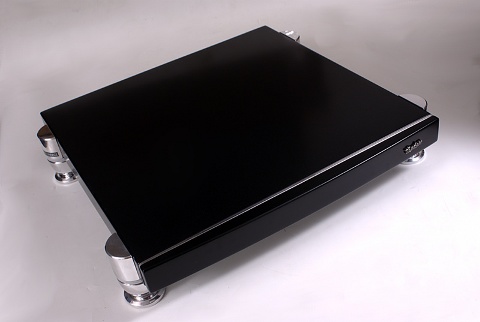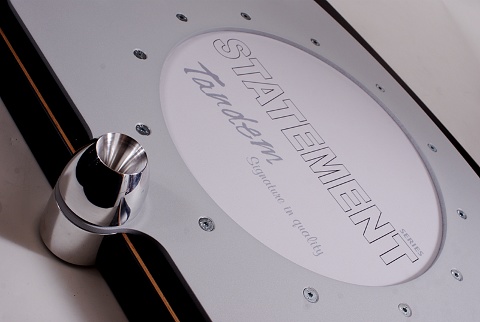about Audio, High Fidelity
& Home Entertainment technologies
pid: 607-2025/10/01 (v1.2)
Privacy Policy

The truth is that, macroscopically at least, you don't have many things to say about the physical presence of both the Statement and the Ultimate, as the photos should be enough. The observant reader may already have spotted that the two stands differ in the number of support points, the Statement using three and the Ultimate four of them. They also are differently finished, the Ultimate using good quality lacquer (also sufficiently resistant to hard use -as we had the opportunity to confirm during the unforgiving review process) and the Statement referring more to Tandem's classic “woody” finish. Both stands include the characteristic curved front, thus breaking the rather conservative feeling that a simple, solid, rectangular platform imposes.
An interesting difference from the rack, could be spotted at the support system. The cone-shaped support points are no longer divided in two pieces but they are machined as one block of aluminum, resting on plates with a special spiral configuration at the surface that comes into contact with the floor. According to Michelios, this approach (the spiral having a triangular cross section) provides by far a better coupling.
The Statement uses three support points. Its finish, as in the case of the more expensive model, was very well crafted.
Those who know one or two things about Tandem's philosophy, will also know, perhaps, that the company particularly dislikes the idea of a spike of any kind and avoids them altogether. The reason for this is that the company's basic design principle is to ensure the easiest possible transfer of the equipment-generated vibration to the floor while creating a high resistance path from the floor to the supporting surface. To this end, each cone-shaped support ends in an annular surface, extremely small in width, in an effort to offer a one-point contact between the cone and the corresponding disc-shaped metal plate. The shape of the disc surface is rather complicated and it is the subject of a patent awarded to Tandem (not much detail given, here…). The initial feeling during the installation, might be a little "relaxed" and with some mechanical tolerance but when everything comes into place, and the stand is leveled, the whole system seems to have excellent fit and stability, even when unloaded.
Tandem's new support points are now machined as a one piece, aluminum cone-shaped part. Every support point is connected with the main body of the stand through the metal frame. The upper cylindrical part shown in the photo is an aesthetic supplement and less a functioning part of the whole structure.
Each of the three (or four, in the case of the Ultimate) support points is anchored in the stand through its metal frame via a large diameter thread formed on its top. Through this thread, leveling of the stand is achieved by simply rotating each support point. Here, Tandem has resorted to a successful aesthetics trick, "hiding" the whole mechanism beneath a metal cylinder that seems to be a part of the support point. Careful observation, however, shows that in fact, the only mechanical connection is between the support point and the metal frame that lies beneath the stand. This frame is in fact an aluminum plate, a material that is selected on its suitability using acoustic criteria and, from what we have understood, is a common choice for all Tandem products. The acoustic behavior of the frame is controlled, partly, by the large circular bore in the center, while near its perimeter Allen head bolts are used to connect the frame with the internal frame of the stand surface which is, also, made of metal.
The metal plates used to couple each support point to the floor are spirally shaped, with a triangular cross section. On the back of the each cone-shaped support point, a large thread allows the correct leveling of the stand.
This surface, the "shelf" in effect, hides some of the crucial components Tandem is using in their products. Michelios was understandably reluctant to share all the details with us, especially for the Ultimate version, but the basic structure is already known: We are dealing with a complex sheet-wood sandwich with a height of 46 mm, where between the wood surfaces lies a big number of small (20x20x20mm) wooden cube blocks along with a metallic particle damping material. The differences between the two stands, the Statement and the Ultimate, focus on the fact that both the wood and the internal metal parts used are different (Tandem says that Ultimate uses a rather exotic timber that belongs to the ebony family). This leads to a significant variation in mass: While Statement weighs about 7kg, the Ultimate reaches 14kg, although their dimensions are similar. The height of each stand (from the floor to the bottom surface of the shelf) is 62 mm.
Each cone ends in an annular surface with a very small width, that fits precisely to the specially shaped groove of the metal plate. The whole of this support mechanism is part of the Tandem's patented technology.







